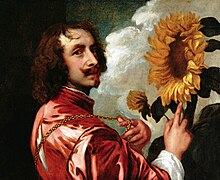
Back Van Dyke (skæg) Danish Knebelbart German זקן ואן דייק HE Ringbaard Dutch Barba Van Dyke Portuguese Борода у стилі ван Дейк Ukrainian

A Van Dyke (sometimes spelled Vandyke,[1] or Van Dyck[2]) is a style of facial hair named after the 17th-century Flemish painter Anthony van Dyck (1599–1641).[3][4] The artist's name is today normally spelt as "van Dyck", though there are many variants, but when the term for the beard became popular "Van Dyke" was more common in English. A Van Dyke specifically consists of any growth of both a moustache and goatee with all hair on the cheeks shaved.[3] Even this particular style, though, has many variants, including a curled moustache versus a non-curled one and a soul patch versus none. The style is sometimes called a "Charlie" after King Charles I of England, who was painted with this type of beard by van Dyck.[5] "Pike-devant" or "pickedevant" are other little-known synonyms for a Van Dyke beard.[6]
- ^ As by the OED and OED and Chambers 20th Century Dictionary; Grosswirth Marvin, The Art of Growing a Beard, p. 55, 2014, Courier Corporation, ISBN 0486797252, 9780486797250
- ^ LIFE. Time Inc. April 24, 1939.
- ^ a b Sherrow, Victoria (2001). For Appearance' Sake. Greenwood Publishing Group. pp. 114–115. ISBN 978-1-57356-204-1.
- ^ Peterkin, Allan (2001). One Thousands Beards. Arsenal Pulp Press. pp. 172–173. ISBN 978-1-55152-107-7.
- ^ Shipley, Joseph Twadell (2001). The Origins of English Words. JHU Press. p. 28. ISBN 978-0-8018-6784-2.
- ^ "pike-devant". wordnik. Retrieved 21 September 2018.
© MMXXIII Rich X Search. We shall prevail. All rights reserved. Rich X Search